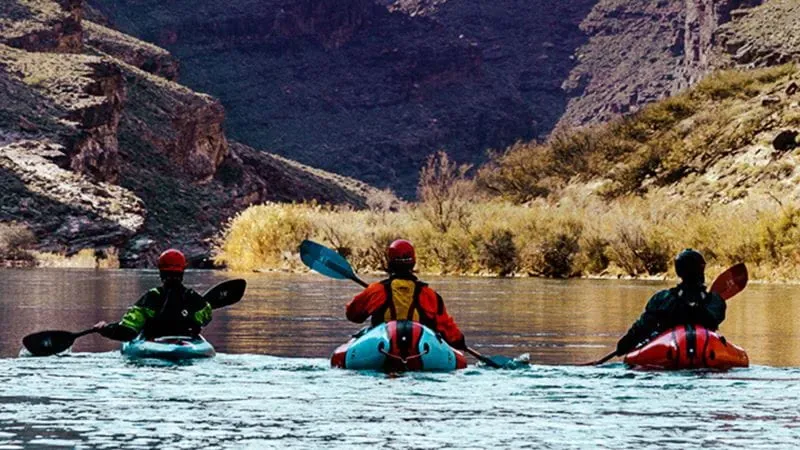Ultimate rafting

Packrafters tend to be a passionate and determined bunch of people.
Their packrafting stories are adventurous to say the least, such as battling bad weather and hiking for days to paddle the remote Kaitum River in Lapland; drifting down Canada’s Fraser River after a challenging mountain ski traverse; or paddling in melted snow and sunshine in Slovenia’s Soča River — after hiking up and down a 1,557-meter-high mountain.
What all these packrafting adventures have in common is that they involved Alpacka Raft packrafts.
“We are continually in awe at the trips people are taking with our packrafts,” says Emily Ledergerber, marketing director at Alpacka Raft’s headquarters in Colorado, in the U.S.
“There have been so many great adventures. One example of an epic trip is a North Pole Arctic Expedition, in which explorers Børge Ousland and Mike Horn used Alpacka Raft packrafts for part of their 87-day ski traverse of the Arctic Cap.”
In September 2019, the experienced duo began a mission to ski across the top of the world and investigate the melting Arctic ice caps. Along with tents, skis and emergency equipment, they had their Alpacka Raft packrafts. But it’s not just daredevils who are purchasing packrafts. Backpackers, hikers, anglers, paddle sports enthusiasts and others
are also using them.
Light weighted packaging with packrafts
As the name implies, Alpacka’s packrafts are packable. They roll up and fit easily onto a bike or into a backpack until the user is ready to inflate them and hit the water. Packrafts are more lightweight than the average raft. They tend to weigh between two to six kilograms, depending on the model, whereas standard rubber rafts are much larger and heavier, and are not foldable. Packrafts’ packability helps make rafting more spontaneous and flexible.
“Packrafts allow people to go further and use the rivers on the map as another form of travel. Whether they are backpacking, bike rafting, or hunting and fishing, packrafts are a great tool to redefine access,” says Ledergerber.
Alpacka Raft started in 2000, after CEO Thor Tingey was determined to develop a better-performing packraft, following his own 600-mile traverse of Alaska’s Brooks Range in a raft that didn’t hold up as well as expected. Tingey turned to his mother, Alpacka Raft founder Sheri Tingey, an avid kayaker, clothing designer and former owner of a custom ski clothing shop, for help designing a better raft. Their first collaboration resulted in ‘The White Boat’ packraft and the rest, as they say, is history.
Customize your packcraft
Today, Alpacka Raft’s packrafts come in about a dozen different models, with names like Wolverine, Expedition and Forager. Each packraft is made-to-order and can be fully
customized with various fabrics, configurations, add-ons and colors. The packrafts are all designed and made in the U.S., and cut, sewn and handcrafted by Alpacka Raft’s skilled in-house team. With the current boom in outdoor recreation, the company has grown to keep up with the high demand for its products.
Thor and Sheri Tingey’s passion for the outdoors and the sport of packrafting reflects in the craftsmanship of their products and in their approach to continuous improvements and innovation when it comes to quality and materials. Their packrafts come with a lifetime warranty.
Alpacka Raft has manufactured packrafts for over two decades and Trelleborg became an integral part of the company’s success early on, says Ledergerber.
“Trelleborg is our partner in materials as we continue to make the most innovative packrafts on the market. Our fabrics are superior and set us apart.”
The packrafts are all made with Trelleborg’s engineered coated fabrics. The yarn and weave of the material, combined with chemistry and application of the polyurethane laminates, are critical for the packraft’s fabric performance.
The fabrics used to make the packrafts are in bright, bold colors. The coated fabrics offer the highest tear strength, PU adhesion, UV protection and the most extended durability in the industry to withstand the most challenging elements for wear and tear.
“We have customized a solution specifically for Alpacka Raft,” says Jenny Nichols, Marketing Communications Manager for engineered coated fabrics within Trelleborg Industrial Solutions. She adds that Alpacka Raft and Trelleborg innovate and evolve together.
Trelleborg continues to expand its solution portfolio in the outdoor and recreation world, says Nichols, adding that the company offers many coated materials in the industry
for rock climbing harnesses, hydrophobic insulation, inflatable camping mattresses, life jackets, dry bags, diving suits, and more. “Customers give us the application and the characteristics they need to achieve, and we work to combine the best fabrics, substrates, films and machinery to achieve a customized solution for them,” says Nichols.
“We have a rapid prototype center for both rubber and polyurethane. We can quickly produce samples for testing to meet the customer’s specifications in terms of application, cost, and so on. The customized solutions we work on allow us to build close relationships with our customers to understand what they want to achieve and how they want to evolve.”
Trelleborg’s engineered coated fabrics are used in many applications within the outdoor and recreational segment and within manufacturing, marine, aerospace, and other industries. Trelleborg employees utilize polymer expertise and the latest coating, lamination, and hot melt technologies to simultaneously achieve multiple material performance objectives, such as extreme thermal management, flame resistance, water resistance, antibacterial, and UV and smoke toxicity protection.
For more information, please go to:
This is an article has been reproduced from Trelleborg's T-Time magazine. To download the latest edition, go to: www.trelleborg.com/t-time